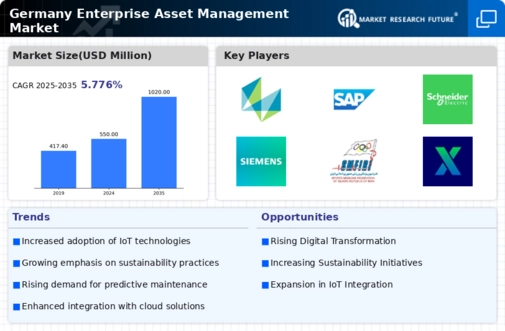Technological Advancements
The enterprise asset-management market in Germany is experiencing a surge due to rapid technological advancements. Innovations in IoT, AI, and machine learning are transforming how organizations manage their assets. These technologies enable real-time monitoring and predictive maintenance, which can lead to a reduction in operational costs by up to 20%. Furthermore, the integration of cloud-based solutions allows for enhanced data accessibility and collaboration across departments. As companies increasingly adopt these technologies, the demand for sophisticated asset-management solutions is likely to grow, indicating a robust future for the enterprise asset-management market.
Growing Regulatory Pressures
Regulatory pressures in Germany are significantly influencing the enterprise asset-management market. Companies are required to comply with stringent regulations regarding asset management, safety, and environmental impact. This compliance necessitates the adoption of advanced asset-management solutions that can ensure adherence to these regulations. The market is expected to grow as organizations invest in systems that facilitate compliance and reporting. It is estimated that the cost of non-compliance can reach up to €1 million for large enterprises, further incentivizing the adoption of effective asset-management practices.
Shift Towards Sustainable Practices
The enterprise asset-management market in Germany is increasingly shaped by a shift towards sustainable practices. Organizations are recognizing the importance of sustainability in their asset management strategies, aiming to reduce their environmental footprint. This shift is reflected in the growing demand for solutions that support sustainable asset management, such as energy-efficient systems and lifecycle assessments. Companies that adopt sustainable practices can enhance their brand reputation and potentially reduce costs associated with energy consumption. As sustainability becomes a core business objective, the enterprise asset-management market is likely to see continued growth.
Increased Focus on Operational Efficiency
In Germany, organizations are placing a heightened emphasis on operational efficiency, which is driving growth in the enterprise asset-management market. Companies are seeking to optimize their asset utilization and reduce downtime, which can lead to significant cost savings. Reports suggest that businesses that implement effective asset-management strategies can improve their operational efficiency by as much as 30%. This focus on efficiency is prompting investments in advanced asset-management systems that provide insights into asset performance and lifecycle management, thereby enhancing decision-making processes.
Rising Demand for Data-Driven Decision Making
The enterprise asset-management market in Germany is witnessing a rising demand for data-driven decision-making. Organizations are increasingly recognizing the value of data analytics in optimizing asset performance and reducing costs. By leveraging data, companies can make informed decisions regarding asset acquisition, maintenance, and disposal. This trend is supported by the fact that businesses utilizing data analytics in their asset-management strategies report a 25% increase in productivity. As the importance of data continues to grow, the enterprise asset-management market is likely to expand, driven by the need for sophisticated analytical tools.






















Leave a Comment